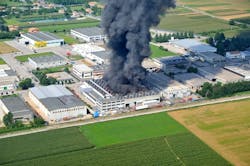Factory Fires Top Reason for Supply Chain Disruption in 2020
For the third year in a row, the two top events causing supply chain disruption were factory fires and changes in ownership of supplier firms. Business sales, factory disruptions, and human health rounded out the top 5 supply chain disruptions in 2020, according to data released from Resilinc’s 2020 Annual EventWatch Report.
EventWatch sent alerts on nearly 1,000 factory fires in 2020, up 67% year-over-year. Of these, about 200 factory fires were impactful enough to trigger the creation of what the company refers to as WarRoom. The report cited a fire in July at a Nittobo plant in Sakurashimo, Fukushima, Japan, which disrupted supplies of fiberglass to ABF substrate producers, which in turn caused delays at manufacturers of high-end servers, networking chips, and CPUs. Another fire, also in Japan cut into supplies of advanced sensing devices used in automotive and other industries. Both these events intensified the massive shortage of semiconductors that will cost the automotive industry as much as $61 billion in lost sales this year.
The report, issued on April 22, also reveals supply chain disruptions were up 67% year-over-year, with 83% of disruptive events being human-caused. While human health disruptions - which include COVID-19 related events - ranked fifth in terms of the number of event alerts (Resilinc sent out 453 alerts regarding human-health related disruptions), the disruption caused by pandemic was more damaging than any other event type. COVID-19, and the government policies enacted in response to it, created deeper global impacts, leading Resilinc to designate the event as “severe” - the first time in the company’s history ranking an event at that level of impact.
In total in 2020, Resilinc sent out 6,192 alerts about potential supply chain disruptions to its customers - which include today’s largest multinational organizations; that’s a 67% increase over 2019. Of these potential disruptions, 3,727, or 60%, were impactful enough to trigger the creation of a WarRoom—virtual platforms in the Resilinc dashboard where customers and their suppliers communicate and collaborate to assess and resolve disruptions.
In 2020, WarRoom creation was up 80% year over year due mostly to pandemic-related threats pushing supply chain teams to develop contingency plans, including finding alternate suppliers.
Additional data revealed in the report includes the number of disruptions by region: North America experienced the most disruptions (2,935), followed by Asia (1,323), and Europe (1,210).
Resilinc’s Annual Report data is gathered from the company’s EventWatch AI, a 24/7 global event monitoring service that contextualizes and analyzes more than 1.7 billion news feeds about potential and existing supply chain disruptions from approximately 3.5 million sources in 100 languages.
